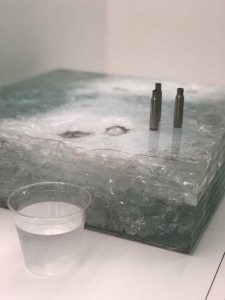
Laminated glass products often carry a low-hazard level in a bomb blast because it has exposed glass on both sides. Much like bullet-resistant glass that spalls when a bullet makes impact, laminated glass for a bomb blast spalls when struck by a blast wave. The fragmentation from laminated glass typically comprises small pieces unlikely to cause any bodily injury or damage to the interior space of a facility.
In retrofit projects, laminated glass is a more expensive investment than a surface-applied film. However, laminated glass might have a lower life-cycle cost due to the frequent replacement film products require.
Wind-borne debris
Glass and glazing systems designed to prevent against wind-borne debris follow the same idea as blast-resistant systems where the entire structure must be able to resist an event. If one component fails, the risk of injury increases and the building’s integrity may be compromised. Unlike blast, wind-borne debris testing requires missile (wooden 2 x 4 or 10 of 2-g [0.07 oz] steel balls) impacts at the glass and/or system along with positive and negative pressurized air. The two types of events prominently associated with wind-borne debris are hurricanes and tornadoes.
Applications designed to be hurricane-resistant must comply with one of the following codes:
- ASTM E 1886, Standard Test Method for Performance of Exterior Windows, Curtainwalls, Doors, and Impact Protective Systems Impacted by Missile(s) and Exposed to Cyclic Pressure Differentials;
- ASTM E 1996, Standard Specification for Performance of Exterior Windows, Curtainwalls, Doors and Impact Protective Systems Impacted by Windborne Debris in Hurricanes;
- Florida Building Code (FBC);
- Testing Application Standard (TAS) 201, Impact Testing;
- TAS 202, Air/Water Testing; and
- TAS 203, Cyclic Testing.
FBC’s High Velocity Hurricane Zone (HVHZ) testing is more stringent than ASTM E 1886/1996 testing as the former needs two large missile (4 kg [9-lb] wooden 2 x 4) impacts on the glazing and one large missile impact on a surrounding framing member, whereas the latter requires just one large missile impact to the glazing. FBC’s HVHZ allows no opening greater than 1.6 x 127 mm (1/16 x 5 in.) while ASTM allows openings up to 76-mm (3-in.) sphere. When it comes to the small missile (10 of 2-g steel balls) test, the HVHZ testing requires all floors—9 m (30 ft) and above—to pass testing, whereas ASTM only requires floors 9 to 18 m (30 to 60 ft) to pass a small missile testing.
In both standards, the ‘Level D’ large missile testing is most common with projectile traveling at 50 m/s (34 mph). However, ‘Level E’ requirements are on the rise with the projectile traveling fast at 80 m/s (50 mph). Additionally, both standards require cyclic wind pressure testing where a test specimen after impact testing receives 9000 pulses of pressurized air based on design requirements.
With regard to tornado-resistance, which are tested similarly to hurricanes with the exception of a heavier 7-kg (15-lb) large missile and shorter duration of cyclic pressures, the International Code Council (ICC) 500, Construction of Storm Shelters, and Federal Emergency Management Agency (FEMA) P-361, Safe Rooms for Tornadoes and Hurricanes Guidance for Community and Residential Safe Rooms, are often referenced. However, there are slight differences between the two (Figure 3).
The glazing employed for systems compliant with ICC 500 and/or FEMA P-361 is always laminated and often 38 mm (1 ½ in.) or more in thickness, and contains a plastic interior surface. Much like bullet-resistant, no-spall glazing, the glass rating for tornadoes must also have zero spall. For this reason, and the limited size availability in glazing that has passed tornado testing, it is not common to employ glazing in safe shelters and rooms.
Conclusion
As architectural design continues to use more and more glazing, it is important to consider the use of protective glazing, especially in today’s world. One must understand the options, testing, and purpose for using such products and how to best implement them in either new construction or existing structures. Project teams must first determine what the glazing system is trying to prevent. For example, is the need to stop bullets, or prevent the assailant from getting into the building and then spreading bullets? Protective security glazing merely helps one prepare against a potential event. One must never assume it will not happen to them as history leaves no one untouchable.




